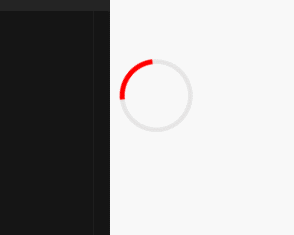您好,登錄后才能下訂單哦!
您好,登錄后才能下訂單哦!
這篇文章主要講解了“即插即用的Vue Loading插件怎么實現”,文中的講解內容簡單清晰,易于學習與理解,下面請大家跟著小編的思路慢慢深入,一起來研究和學習“即插即用的Vue Loading插件怎么實現”吧!
無論最終要實現怎樣的網站,Loading狀態都是必不可少的一環,給用戶一個過渡喘息的機會也給服務器一個遞達響應的時間。
從使用方式說起
不管從0開始寫起還是直接下載的Loading插件,都會抽象為一個組件,在用到的時候進行加載Loading,或者通過API手動進行show或者hide
<wait>
</wait>
...
this.$wait.show()
await fetch('http://example.org')
this.$wait.hide()或者通過Loading狀態進行組件間的切換
<loader v-if="isLoading"> </loader> <Main v-else> </Main>
要想注冊成全局狀態,還需要給axios類的網絡請求包添加攔截器,然后設置一個全局Loading狀態,每次有網絡請求或者根據已經設置好的URL將Loading狀態設置為加載,請求完成后在設置為完成。
注冊axios攔截器:
let loadingUrls = [
`${apiUrl}/loading/`,
`${apiUrl}/index/`,
`${apiUrl}/comments/`,
...
]
axios.interceptors.request.use((config) => {
let url = config.url
if (loadingUrls.indexOf('url') !== -1) {
store.loading.isLoading = true
}
})
axios.interceptors.response.use((response) => {
let url = response.config.url
if (loadingUrls.indexOf('url') !== -1) {
store.loading.isLoading = false
}
})使用時在每個組件下獲取出loading狀態,然后判斷什么時候顯示loading,什么時候顯示真正的組件。
<template>
<div>
<loader v-if="isLoading">
</loader>
<Main v-else>
</Main>
</div>
</template>
<script>
...
components: {
loader
},
computed: {
isLoading: this.$store.loading.isLoading
},
async getMainContent () {
// 實際情況下State僅能通過mutations改變.
this.$sotre.loading.isLoading = false
await axios.get('...')
this.$sotre.loading.isLoading = false
},
async getMain () {
await getMainContent()
}
...
</script>在當前頁面下只有一個需要Loading的狀態時使用良好,但如果在同一個頁面下有多個不同的組件都需要Loading,你還需要根據不同組件進行標記,好讓已經加載完的組件不重復進入Loading狀態...隨著業務不斷增加,重復進行的Loading判斷足以讓人煩躁不已...
整理思路
Loading的核心很簡單,就是請求服務器時需要顯示Loading,請求完了再還原回來,這個思路實現起來并不費力,只不過使用方式上逃不開上面的顯式調用的方式。順著思路來看,能進行Loading設置的地方有,
設置全局攔截,請求開始前設置狀態為加載。
設置全局攔截,請求結束后設置狀態為完成。
在觸發請求的函數中進行攔截,觸發前設置為加載,觸發后設置為完成。
判斷請求后的數據是否為非空,如果非空則設置為完成
最終可以實現的情況上,進行全局攔截設置,然后局部的判斷是最容易想到也是最容易實現的方案。給每個觸發的函數設置before和after看起來美好,但實現起來簡直是災難,我們并沒有before和after這兩個函數鉤子來告訴我們函數什么時候調用了和調用完了,自己實現吧坑很多,不實現吧又沒得用只能去原函數里一個個寫上。只判斷數據局限性很大,只有一次機會。
既然是即插即用的插件,使用起來就得突出一個簡單易用,基本思路上也是使用全局攔截,但局部判斷方面與常規略有不同,使用數據綁定(當然也可以再次全局響應攔截),咱們實現起來吧~。
樣式
Loading嘛,必須得有一個轉圈圈才能叫Loading,樣式并不是這個插件的最主要的,這里直接用CSS實現一個容易實現又不顯得很糙的:
<template>
<div class="loading">
</div>
</template>
...
<style scoped>
.loading {
width: 50px;
height: 50px;
border: 4px solid rgba(0,0,0,0.1);
border-radius: 50%;
border-left-color: red;
animation: loading 1s infinite linear;
}
@keyframes loading {
0% { transform: rotate(0deg) }
100% { transform: rotate(360deg) }
}
</style>固定大小50px的正方形,使用border-radius把它盤得圓潤一些,border設置個進度條底座,border-left-color設置為進度條好了。

綁定數據與URL
提供外部使用接口
上面思路中提到,這個插件是用全局攔截與數據綁定制作的:
暴露一個 source 屬性,從使用的組件中獲取出要綁定的數據。
暴露一個 urls 屬性,從使用的組件中獲取出要攔截的URL。
<template>
...
</template>
<script>
export default {
props: {
source: {
require: true
},
urls: {
type: Array,
default: () => { new Array() }
}
},
data () {
return { isLoading: true }
},
watch: {
source: function () {
if (this.source) {
this.isLoading = false
}
}
}
}
</script>
<style scoped>
....
</style>不用關心source是什么類型的數據,我們只需要監控它,每次變化時都將Loading狀態設置為完成即可,urls我們稍后再來完善它。
設置請求攔截器
攔截器中需要的操作是將請求時的每個URL壓入一個容器內,請求完再把它刪掉。
Vue.prototype.__loader_checks = []
Vue.prototype.$__loadingHTTP = new Proxy({}, {
set: function (target, key, value, receiver) {
let oldValue = target[key]
if (!oldValue) {
Vue.prototype.__loader_checks.forEach((func) => {
func(key, value)
})
}
return Reflect.set(target, key, value, receiver)
}
})
axios.interceptors.request.use(config => {
Vue.prototype.$__loadingHTTP[config.url] = config
return config
})
axios.interceptors.response.use(response => {
delete Vue.prototype.$__loadingHTTP[response.config.url]
return response
})將其掛載在Vue實例上,方便我們之后進行調用,當然還可以用Vuex,但此次插件要突出一個依賴少,所以Vuex還是不用啦。
直接掛載在Vue上的數據不能通過computed或者watch來監控數據變化,咱們用Proxy代理攔截set方法,每當有請求URL壓入時就做點什么事。Vue.prototype.__loader_checks用來存放哪些實例化出來的組件訂閱了請求URL時做加載的事件,這樣每次有URL壓入時,通過Proxy來分發給訂閱過得實例化Loading組件。
訂閱URL事件
<template>
...
</template>
<script>
export default {
props: {
source: {
require: true
},
urls: {
type: Array,
default: () => { new Array() }
}
},
data () {
return { isLoading: true }
},
watch: {
source: function () {
if (this.source) {
this.isLoading = false
}
}
},
mounted: function () {
if (this.urls) {
this.__loader_checks.push((url, config) => {
if (this.urls.indexOf(url) !== -1) {
this.isLoading = true
}
})
}
}
}
</script>
<style scoped>
....
</style>每一個都是一個嶄新的實例,所以直接在mounted里訂閱URL事件即可,只要有傳入urls,就對__loader_checks里每一個訂閱的對象進行發布,Loader實例接受到發布后會判斷這個URL是否與自己注冊的對應,對應的話會將自己的狀態設置回加載,URL請求后勢必會引起數據的更新,這時我們上面監控的source就會起作用將加載狀態設置回完成。
使用槽來適配原來的組件
寫完上面這些你可能有些疑問,怎么將Loading時不應該顯示的部分隱藏呢?答案是使用槽來適配,
<template>
<div>
<div class="loading" v-if="isLoading" :key="'loading'">
</div>
<slot v-else>
</slot>
</div>
</template>
<script>
export default {
props: {
source: {
require: true
},
urls: {
type: Array,
default: () => { new Array() }
}
},
data () {
return { isLoading: true }
},
watch: {
source: function () {
if (this.source) {
this.isLoading = false
}
}
},
mounted: function () {
if (this.urls) {
this.__loader_checks.push((url, config) => {
if (this.urls.indexOf(url) !== -1) {
this.isLoading = true
}
})
}
}
}
</script>
<style scoped>
....
</style>還是通過isLoading判斷,如果處于加載那顯示轉圈圈,否則顯示的是父組件里傳入的槽,
這里寫的要注意,Vue這里有一個奇怪的BUG,
<div class="loading" v-if="isLoading" :key="'loading'"> </div> <slot v-else> </slot>
在有<slot>時,如果同級的標簽同時出現v-if與CSS選擇器且樣式是scoped,那用CSS選擇器設置的樣式將會丟失,<div v-if="isLoading" :key="'loading'">如果沒有設置key那.loading的樣式會丟失,除了設置key還可以把它變成嵌套的<div v-if="isLoading"> <div></div> </div>。
注冊成插件
Vue中的插件有四種注冊方式,這里用mixin來混入到每個實例中,方便使用,同時我們也把上面的axios攔截器也注冊在這里。
import axios
import Loader from './loader.vue'
export default {
install (Vue, options) {
Vue.prototype.__loader_checks = []
Vue.prototype.$__loadingHTTP = new Proxy({}, {
set: function (target, key, value, receiver) {
let oldValue = target[key]
if (!oldValue) {
Vue.prototype.__loader_checks.forEach((func) => {
func(key, value)
})
}
return Reflect.set(target, key, value, receiver)
}
})
axios.interceptors.request.use(config => {
Vue.prototype.$__loadingHTTP[config.url] = config
return config
})
axios.interceptors.response.use(response => {
delete Vue.prototype.$__loadingHTTP[response.config.url]
return response
})
Vue.mixin({
beforeCreate () {
Vue.component('v-loader', Loader)
}
})
}
}使用
在入口文件中使用插件
import Loader from './plugins/loader/index.js' ... Vue.use(Loader) ...
任意組件中無需導入即可使用
<v-loader :source="msg" :urls="['/']">
<div @click="getRoot">{{ msg }}</div>
</v-loader>根據綁定的數據和綁定的URL自動進行Loading的顯示與隱藏,無需手動設置isLoading是不是該隱藏,也不用調用show與hide在請求的方法里打補丁。
其他
上面的通過綁定數據來判斷是否已經響應,如果請求后的數據不會更新,那你也可以直接在axios的response里做攔截進行訂閱發布模式的響應。
Vue是一款友好的、多用途且高性能的JavaScript框架,使用vue可以創建可維護性和可測試性更強的代碼庫,Vue允許可以將一個網頁分割成可復用的組件,每個組件都包含屬于自己的HTML、CSS、JavaScript,以用來渲染網頁中相應的地方,所以越來越多的前端開發者使用vue。
感謝各位的閱讀,以上就是“即插即用的Vue Loading插件怎么實現”的內容了,經過本文的學習后,相信大家對即插即用的Vue Loading插件怎么實現這一問題有了更深刻的體會,具體使用情況還需要大家實踐驗證。這里是億速云,小編將為大家推送更多相關知識點的文章,歡迎關注!
免責聲明:本站發布的內容(圖片、視頻和文字)以原創、轉載和分享為主,文章觀點不代表本網站立場,如果涉及侵權請聯系站長郵箱:is@yisu.com進行舉報,并提供相關證據,一經查實,將立刻刪除涉嫌侵權內容。